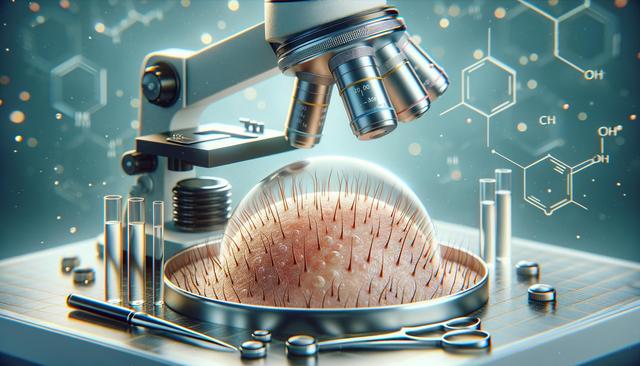Understanding Alopecia Areata Treatment Options
Alopecia areata is an autoimmune condition that leads to hair loss, and understanding available treatment options can help individuals manage the condition more effectively.

Understanding Alopecia Areata and Its Causes
Alopecia areata is a complex autoimmune disorder where the immune system mistakenly targets hair follicles, resulting in patchy hair loss typically seen on the scalp, though it can affect other areas of the body. The exact cause is not fully understood, but it is believed to involve a combination of genetic and environmental factors. For individuals exploring how to regrow alopecia hair, it’s essential to begin by understanding the nature of the condition and how it disrupts normal hair growth cycles. Although hair follicles remain alive in most cases, the immune attack causes them to become dormant, halting hair production temporarily or, in some cases, long term.
Common triggers that may contribute to the onset or worsening of alopecia areata include:
- Physical or emotional stress
- Hormonal changes
- Viral infections
- Family history of autoimmune diseases
By recognizing these factors, individuals and healthcare providers can develop more targeted strategies for alopecia treatment. Early diagnosis and intervention improve the chances of managing symptoms and possibly reversing hair loss.
Medical Treatments Prescribed by Dermatologists
When seeking professional help for alopecia areata, many individuals wonder: what do dermatologists prescribe for hair loss? Dermatologists typically recommend treatments based on the severity and extent of the condition. For small, localized bald spots, topical corticosteroids are commonly used to suppress the immune response and promote hair regrowth. These are available in creams, ointments, or foams and may be prescribed for several weeks to months.
In more extensive or persistent cases, the following options may be considered:
- Intralesional corticosteroid injections directly into bald patches
- Oral corticosteroids for systemic treatment
- Topical immunotherapy using chemicals like diphencyprone (DPCP) to trigger a mild allergic reaction and re-stimulate hair growth
- JAK inhibitors (under medical supervision) which target specific immune pathways involved in alopecia areata
These therapies aim to reduce inflammation and encourage hair follicles to resume normal growth. When exploring hair loss treatment paths, it’s important to work closely with a dermatologist to monitor progress and adjust methods as needed.
Natural and Over-the-Counter Approaches
In addition to prescription medications, many individuals explore over-the-counter and natural remedies as part of a broader plan for how to regrow hair on bald spot areas. While these options may not offer immediate or guaranteed results, they can complement medical treatments and support the overall health of the scalp and hair follicles. Some commonly used products include topical minoxidil, which is available without a prescription and has shown some effectiveness in stimulating hair regrowth in alopecia areata.
Other supportive approaches include:
- Essential oils like rosemary or peppermint oil, which may enhance circulation to the scalp
- Scalp massage to encourage blood flow
- Dietary supplements such as biotin, zinc, and vitamin D, especially if deficiencies are present
- Low-level laser therapy (LLLT) devices for at-home use
While these methods are generally safe, it’s important to consult with a healthcare provider before starting new treatments to ensure they are appropriate for your specific case.
Lifestyle Adjustments and Holistic Support
Managing alopecia areata often involves more than just treating the physical symptoms. Emotional and psychological support is crucial, as hair loss can significantly affect self-esteem and mental health. Making lifestyle adjustments and adopting holistic practices can play a key role in coping with the condition and potentially improving outcomes.
Consider incorporating the following lifestyle strategies:
- Stress management techniques such as meditation, yoga, or cognitive behavioral therapy
- A balanced diet rich in antioxidants, lean proteins, and omega-3 fatty acids
- Regular physical activity to boost overall immune function
- Avoidance of harsh hair treatments or styles that put tension on the scalp
By taking a whole-person approach, individuals may find better ways to support their bodies and minds during treatment. Understanding how to regrow alopecia hair is not just about medication—it also involves nurturing the body from within and creating an environment conducive to healing.
Tracking Progress and Setting Realistic Expectations
Recovering from alopecia areata is often a process that requires patience and persistence. Hair regrowth is unpredictable and can vary significantly from one person to another. Some may see regrowth in a few months, while others may deal with recurring cycles of hair loss and regrowth. Tracking changes over time through photographs or a hair journal can help individuals and healthcare providers evaluate the effectiveness of treatments.
It’s also important to set realistic expectations. Not every treatment will work for everyone, and it may take trying different approaches to find what works best. Those exploring how to regrow hair on bald spot areas should remain open to adjusting their strategy as new options become available or as their condition evolves. Staying informed and maintaining regular check-ins with a dermatologist can make a significant difference in long-term management.
For anyone navigating alopecia treatment, understanding the variety of available methods—from medical interventions to holistic support—can empower them to take active steps toward managing their condition and improving their quality of life.
Conclusion
Managing alopecia areata involves a multifaceted approach that includes medical treatments, lifestyle changes, and emotional support. Whether you’re researching how to regrow alopecia hair or seeking answers to what do dermatologists prescribe for hair loss, the key lies in personalized care and ongoing collaboration with healthcare providers. By staying informed and proactive, individuals can make meaningful progress in their journey toward hair restoration and overall well-being.